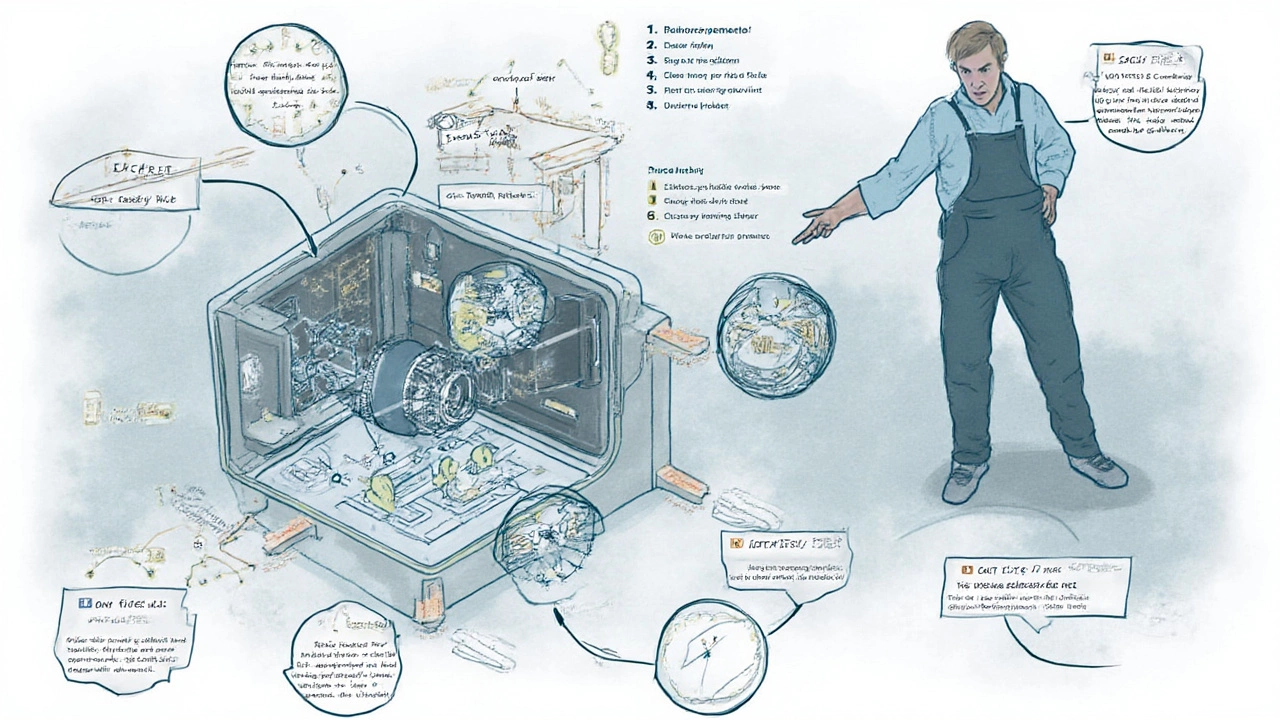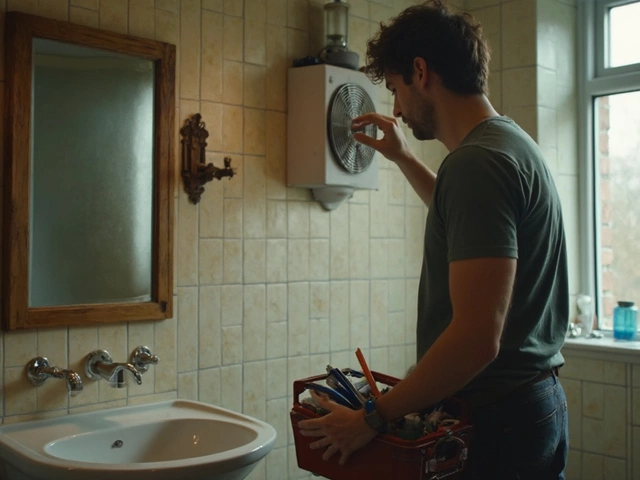Ever tried to make chicken curry in a kitchen with a busted extractor fan? Or maybe your bathroom smells like a locker room after football practice, no matter how many scented candles you light. Extractor fans play hero every day, whisking away steam, odours, and grease. But when they break, it’s not always clear who you need to call—or whether you can fix the thing yourself. If you’re reading this, you probably want the real answer, not a runaround. Let's get into the world of extractor fan repair, armed with facts, trade wisdom, and a few things you might not have thought of.
Who Fixes Extractor Fans? Understanding the Needed Trade Skills
Most people’s first instinct is to call an electrician when an extractor fan stops working. That’s logical—fans need power, switches, and occasionally timers that tie into a room’s lighting circuit. Electricians, especially those experienced with home appliance repairs, are the go-to choice for most domestic extractor fan problems. They can diagnose wiring faults, faulty switches, dead motors, and installation issues. But here’s a twist: not all extractor fan repairs stay in the world of electrics.
If the problem relates to poor ventilation or blocked ductwork (maybe birds decided your vent was prime real estate), then a ventilation specialist or even a general builder with experience in airflow management might be the right call. Some extractor fans, especially commercial kitchen models, are connected to more complex ventilation systems—think ducting running across the roof with powerful motors. In those cases, a specialist HVAC (heating, ventilation, and air conditioning) engineer steps in.
It’s also worth mentioning that installers who regularly fit bathrooms and kitchens will often have enough extractor fan know-how to tackle basic problems or swaps. But if any hardwired electrics are involved, sticking with a certified electrician keeps things both safe and legal. In the UK, regulations like Part P of the Building Regulations require a qualified electrician to handle bathroom electrics due to water and wiring proximity—don’t risk your safety or home insurance going off-piste. The rule? For replacement, rewiring or fault-finding, electricians rule. For blockages and ducting issues, ventilation or building pros. If you’re not sure, ask when you call.
The Most Common Extractor Fan Problems (And How to Spot Them)
Knowing what usually goes wrong with extractor fans can save a lot of head-scratching—and possibly a service call. Let’s break down the biggest fan failures:
- Dead or Stuck Fans: The fan doesn’t run at all. Usually smells a bit burnt when it’s a dead motor. Other causes include a blown fuse or broken switch.
- Weird Noises or Vibration: Grinding, rattling, or screeching sounds aren’t normal. These usually mean there’s something caught in the fan (lots of fluff), the bearings have worn, or the blades are off-balance.
- Poor Ventilation: If the fan runs but nothing seems to move, the ducting might be clogged or the extraction path blocked. Sometimes, cheaper fans get overwhelmed by sticky kitchen grease or bathroom lint.
- Won’t Switch Off: Some fans are wired to turn off after a delay—but if yours runs for hours, a faulty timer relay or control module could be the issue.
- Noisy but No Power: Occasionally, you’ll hear only humming without the blades turning, pointing to an electrical fault or seized shaft.
A quick way to diagnose? Flip the main fuse and see if power is reaching the unit. If you have a vent you can reach, check for suction—use a piece of tissue and see if it’s pulled against the grille. If there’s no suction and you hear the fan, suspect a ducting clog. If you smell smoke or notice sudden fan silence, switch the power off and get an electrician, stat.
Oddly enough, a 2023 survey showed nearly 60% of extractor fan failures in UK homes were caused by wiring issues rather than mechanical breakdowns—so don’t go buying a new fan before checking basics like fuses and switches. Also, about a quarter of calls involved simple obstructions—cobwebs and bird nests, not complicated faults. It’s usually worth a quick look yourself before making that expensive call.

Electrician, Ventilation Specialist, or DIY? Making the Right Call
Choosing who should fix your fan depends on what’s actually gone wrong. Electricians are your best bet for faults involving wiring, timer controls, or replacing whole fan units. They’ve seen it all: from bathroom fans blowing fuses every shower, to kitchen extractor hoods that suddenly drop dead after a power surge. They know how to test voltage, check for shorts, and replace tricky wiring safely. An important note: DIY electrical repairs can invalidate your home insurance and are illegal in many bathroom setups in the UK, unless you’re certified.
But say you’re dealing with a noisy fan that’s just full of dust or grease: A local handyman—or a mechanical ventilation specialist—might be able to disassemble, clean, and reassemble it. If you suspect birds have blocked the outside vent (happens a lot in spring), you’ll need someone comfortable on ladders, usually a general builder or even a pest control pro if nests are involved.
If the fan hums but barely moves air, or you see lots of condensation despite the motor running, you could have a deeper airflow problem—long runs of ducting, crimped pipes, or buildup inside vents. That’s where a professional who understands airflow rules comes into play. Another tip: a specialist can check if your setup meets current regulations. Many old homes run uninsulated, extra-long ducting that loses power over distance; sometimes a quick upgrade makes rooms dryer and healthier, especially if you have moisture-loving kids like Callista who just can’t take short showers.
Got a newer extractor fan with smart controls, humidity sensors, or integration with home automation systems? These usually need either a trained electrician or a certified installer who’s up to speed on those tech add-ons. More parts = more ways to mess up installation, so don’t cheap out on poorly qualified tradespeople. Never hesitate to ask for qualifications, Part P certification, or proof of insurance when booking anyone to fiddle with wiring.
Repair or Replace? Deciding the Best Route for Your Extractor Fan
Here’s the honest truth: repair isn’t always the right call. If your fan’s more than ten years old and sounding like a jet taking off, replacement probably makes more sense, especially when you consider the energy savings from a modern upgrade. But for relatively new units, fixing can save big cash, especially when the problem is simple—loose wiring, a stuck blade, or minor blockages.
Wondering about costs? Here’s a quick look at average repair and replacement fees, based on 2024 UK data:
| Service | Average Cost (GBP) |
|---|---|
| Fan Cleaning (Bathroom/Kitchen) | £40 - £70 |
| Electrical Fault Repair | £60 - £120 |
| Basic Fan Replacement | £110 - £180 |
| Complex Ductwork Repair | £120 - £250 |
| New Extractor Fan with Smart Features | £200 - £350 |
Always weigh up the cost of repair versus replacement. If replacement is only a bit more expensive, it pays to upgrade—especially as new models are far quieter, more powerful, and easier to keep clean. Ask your repair person what they honestly think; a reputable pro will tell you if it’s worth spending the extra cash. Also, keep those receipts. If your fan was fitted less than a year ago, you might still be under warranty—don’t pay for parts or labour you shouldn’t.
If energy bills are a concern, modern extractor fans can run at half the power of clunky older units, and some even have motion sensors or smart timers to save power. Fancy a model with a humidity sensor? These work wonders for kids who love long steamy baths (looking at you, Callista), kicking in only when needed. Check the energy rating and noise level before you buy—it’s usually stamped on the box or listed on manufacturers’ sites.

Simple Maintenance and Troubleshooting Tips
Before calling in the cavalry, some basic troubleshooting might solve your extractor fan woes. Here’s a quick checklist you can follow, with no special tools required:
- Check the Fuse: If the fan doesn’t work at all, look at the consumer unit or the spur switch fuse near the fan. If it’s blown, replace it. Always switch off power first!
- Inspect the Grille: Dust and fluff stuck in the grille block airflow and make the fan noisy. A quick vacuum or wipe can make a big difference.
- Test the Power Supply: If you have a voltage tester, check that power is reaching the wall switch or fan terminals (with the right safety gear).
- Listen for Noises: Weird rattles? Could be a loose blade, trapped debris, or even a screw coming undone. If you’re comfortable, unscrew the cover and gently remove fluff or objects—not with wet hands, mind you.
- External Vents: If you can get to the outside grille, see if anything’s blocking it. Bird nests, dead leaves, and cobwebs are the usual suspects.
It surprises people how often a basic clean fixes bad smells, poor airflow, and noise. Manufacturers usually recommend checking and cleaning your bathroom or kitchen extractor at least every six months—maybe more if you cook bacon daily or run long baths for the little ones. And here’s a pro tip: if you notice water drips or damp patches on walls near your fan, it’s a hint condensation isn’t clearing. In older properties with longer ducting, consider boosting insulation or switching to an inline model for extra pull.
One last thing: always choose a trusted local professional for electrical repairs or anything complicated. Not only does this protect you and your family, it keeps your warranty (and sanity) intact. If your fan’s acting up and you’ve checked the basics, don’t be shy—a quick call to the right extractor fan repair trade can make your kitchen or bathroom a much happier place. Stay fresh, stay safe, and don’t let your fan become the household villain.




